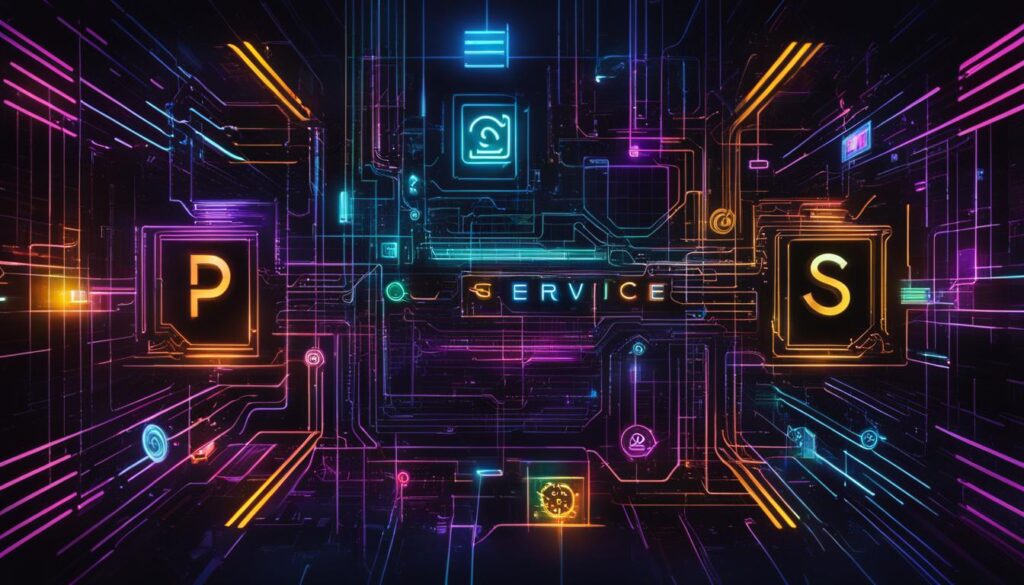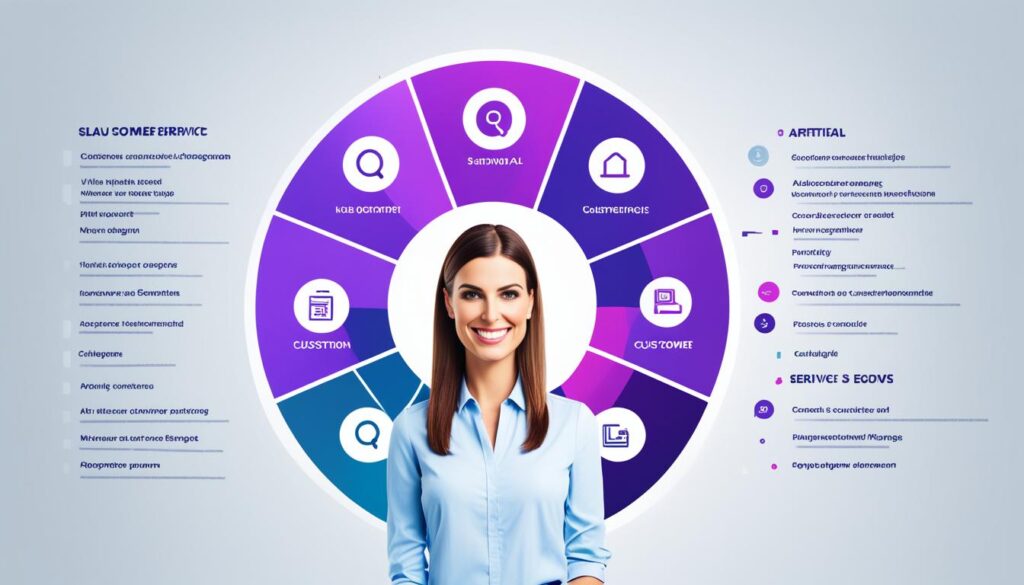In the world of customer service, acronyms and abbreviations are commonly used to describe key concepts and metrics. These acronyms can be confusing for newcomers and even experienced professionals. Understanding these customer service acronyms is essential for effective communication and improving the overall customer experience. In this article, we will explore the meaning and significance of the most common customer service acronyms and abbreviations.
Common Customer Service Acronyms and Abbreviations
Customer service professionals often rely on a wide range of acronyms and abbreviations to effectively communicate key concepts and metrics. Understanding these common customer service acronyms is essential for seamless collaboration and clear communication within the industry.
Here are some of the most frequently used customer service acronyms and abbreviations:
| Acronym | Full Form | Description |
|---|---|---|
| SLA | Service Level Agreement | An agreement that outlines the level of service a customer can expect from a company |
| CSAT | Customer Satisfaction | A metric used to measure the satisfaction of customers with the service provided |
| FTR | First Time Resolution | A metric that measures the percentage of customer issues resolved on the first interaction |
| NPS | Net Promoter Score | A metric used to measure customer loyalty and advocacy |
| IVR | Interactive Voice Response | An automated system that interacts with callers through voice and keypad inputs |
“Understanding customer service acronyms is like speaking the language of the industry. It helps streamline communication and ensures everyone is on the same page.”
Familiarizing yourself with these customer service acronyms and abbreviations will not only enhance your understanding but also enable you to contribute more effectively to the overall customer support efforts. By speaking the language of customer service, you can facilitate smoother interactions and provide better experiences for both customers and colleagues.
Continue reading to explore the meanings behind these customer service acronyms and how they contribute to delivering exceptional service.
Exploring the Meaning of Customer Service Acronyms
Understanding the meaning behind customer service acronyms is vital for effective communication in the industry. These acronyms and abbreviations, such as customer service acronyms, customer support acronyms, CS acronyms, and abbreviations in customer service, play a significant role in enhancing the overall customer experience.
By familiarizing yourself with these acronyms, you will be better equipped to navigate customer service conversations and collaborate effectively with your team. Let’s take a closer look at some of the commonly used customer service acronyms:
- KPI – Key Performance Indicator: A measurable value that indicates the success of a specific customer service activity or goal.
- SLA – Service Level Agreement: An agreement between a service provider and a customer that defines the level of service expected and the metrics used to measure its performance.
- CSAT – Customer Satisfaction: A metric used to measure the level of satisfaction customers have with a product, service, or interaction with a customer service representative.
- NPS – Net Promoter Score: A metric used to measure customer loyalty and their likelihood to recommend a product or service to others.
- FCR – First Call Resolution: The percentage of customer inquiries or issues that are resolved upon initial contact by a customer service representative.
- SLM – Service Level Management: The process of designing, delivering, and managing the agreed-upon levels of service to meet the needs of customers.
Customer service acronyms and abbreviations enhance communication and provide a common language for professionals in the industry. By understanding the meaning behind these acronyms, you can effectively measure performance, assess customer satisfaction, and ensure efficient resolution of customer issues.
Now that we have explored some of the common customer service acronyms, let’s dive deeper into the broader business and technical acronyms that are relevant to the field of customer service.
Broadening the Scope: General Business and Technical Customer Service Acronyms
In addition to customer service-specific acronyms, there are also broader business and technical acronyms that are relevant to the field of customer service. Understanding these acronyms can help you navigate conversations and processes in a professional setting. Here are some of the most common acronyms you may come across:
General Business Acronyms
When dealing with customer service in a business context, you may encounter the following acronyms:
- KPI – Key Performance Indicator
- ROI – Return on Investment
- NPS – Net Promoter Score
- CRM – Customer Relationship Management
- SOP – Standard Operating Procedure
Technical Customer Service Acronyms
If you are involved in technical customer service roles, you may come across these acronyms:
- SLA – Service Level Agreement
- FAQ – Frequently Asked Questions
- CRM – Customer Relationship Management
- TAT – Turnaround Time
- HTML – Hypertext Markup Language
It’s important to familiarize yourself with these general business and technical acronyms to effectively communicate and collaborate with colleagues across different teams. Keeping track of these acronyms will enhance your customer service knowledge and streamline your work processes.

Technical Customer Service Abbreviations
In technical customer service roles, understanding and utilizing the appropriate abbreviations can greatly enhance communication efficiency. These abbreviations are commonly used to refer to specific technical terms and concepts. Here are some of the most frequently used technical customer service abbreviations:
| Abbreviation | Meaning |
|---|---|
| SLA | Service Level Agreement |
| CRM | Customer Relationship Management |
| KPI | Key Performance Indicator |
| FTR | First Time Resolution |
| P1 | Priority 1 |
| SLM | Service Level Management |
These abbreviations are invaluable tools for technical customer service professionals, allowing for clearer and more concise communication when discussing complex technical issues. Knowledge and correct usage of these abbreviations enhance overall productivity and effectiveness in providing exceptional customer support.

Customer Service Acronyms for Guiding Agents
In the fast-paced world of customer service, agents often require quick and effective tools to assist them in providing excellent support. Customer service acronyms serve as useful reminders and guides for agents to enhance their interactions with customers. These acronyms help agents remember key principles, prioritize tasks, and deliver exceptional service. Here are some commonly used customer service acronyms for agents:
CSAT: Customer Satisfaction
FCR: First Call Resolution
SLA: Service Level Agreement
NPS: Net Promoter Score
CRM: Customer Relationship Management
KPI: Key Performance Indicator
QA: Quality Assurance
IVR: Interactive Voice Response
RCA: Root Cause Analysis
TAT: Turnaround Time
CTA: Call to Action
These customer service acronyms help agents focus on crucial aspects of their job, such as customer satisfaction, resolving issues promptly, adhering to service level agreements, measuring customer loyalty, managing customer relationships, tracking performance, ensuring quality, analyzing root causes, and effectively managing response times. By incorporating these acronyms into their everyday work, agents can provide efficient and effective customer service, leading to improved customer experiences.

| Acronym | Meaning |
|---|---|
| CSAT | Customer Satisfaction |
| FCR | First Call Resolution |
| SLA | Service Level Agreement |
| NPS | Net Promoter Score |
| CRM | Customer Relationship Management |
| KPI | Key Performance Indicator |
| QA | Quality Assurance |
| IVR | Interactive Voice Response |
| RCA | Root Cause Analysis |
| TAT | Turnaround Time |
| CTA | Call to Action |
Importance of Proper Usage of Customer Service Abbreviations
While customer service abbreviations can be time-savers and aids in communication, it is crucial to use them appropriately and in the right context.
Improper usage of customer service abbreviations can lead to misunderstandings and miscommunication, defeating the purpose of using acronyms. To ensure effective communication, it is essential to consider the audience and ensure that the recipient understands the meaning of the abbreviation.
When using customer service abbreviations, avoid overusing them and instead use them sparingly to enhance communication rather than creating barriers. Overreliance on abbreviations can make the communication process confusing and can be particularly challenging for customers who may not be familiar with the acronyms used.
Remember, the goal of using customer service abbreviations is to streamline communication and make it more efficient. However, it is essential to strike a balance by using them judiciously and ensuring that they enhance clarity and understanding rather than hinder it.
By using customer service abbreviations in the appropriate manner, you can create a more efficient and seamless customer experience. Clear and concise communication is key to delivering exceptional customer service, and proper usage of abbreviations plays a vital role in achieving that goal.
The Importance of Delivering Exceptional Customer Service
Delivering outstanding customer service is vital for businesses to thrive. Research has shown that providing exceptional customer service has a direct impact on customer satisfaction, loyalty, and ultimately, the success of a business.
According to customer experience statistics, 86% of consumers are willing to pay more for a better customer experience. This highlights the importance of making customer service a top priority in order to attract and retain customers.
Exceptional customer service not only enhances the overall customer experience, but it also has a significant impact on the bottom line. Studies have found that a 5% increase in customer retention can lead to a 25% to 95% increase in profits.
“Customer service is not just a department, it’s an attitude.” – Unknown
When customers receive exceptional service, they are more likely to become loyal brand advocates, promoting your business through positive word-of-mouth. This, in turn, can lead to increased customer acquisition and organic growth.
Key Benefits of Delivering Exceptional Customer Service
- Customer satisfaction: Exceptional customer service ensures that customers have a positive experience with your brand, leading to higher satisfaction levels.
- Customer loyalty: When customers receive outstanding service, they are more likely to remain loyal to your brand and continue doing business with you.
- Brand reputation: Providing exceptional customer service helps build a strong and positive reputation for your brand in the market.
- Competitive advantage: Businesses that consistently deliver exceptional customer service stand out from their competitors, gaining a competitive edge.
- Increase in sales: Satisfied customers are more likely to make repeat purchases and spend more, directly impacting your sales revenue.
Delivering exceptional customer service requires a customer-centric approach, effective communication, and a dedication to resolving customer issues promptly and efficiently. By prioritizing customer service, businesses can create long-lasting relationships with their customers and drive sustainable growth.
Training Formulas for Exceptional Customer Service
Delivering exceptional customer service requires well-trained and knowledgeable customer service teams. To achieve this level of service, businesses can utilize various training formulas and methods that focus on enhancing key skills and cultivating a customer-centric mindset. Here are some effective training formulas for delivering great support:
1. Empathy and Active Listening
“Empathy is about standing in someone else’s shoes, feeling with his or her heart, seeing with his or her eyes. Not only is empathy hard to outsource and automate, but it makes the world a better place.” – Daniel H. Pink
Training customer service representatives in empathy and active listening fosters genuine connections with customers. By understanding and empathizing with customers’ needs and concerns, representatives can provide personalized support and build trust.
2. Effective Communication Techniques
“The art of communication is the language of leadership.” – James Humes
Equipping customer service teams with effective communication techniques is essential for clear and concise interactions. Training should cover aspects such as using positive language, adapting communication styles to different customers, and resolving conflicts peacefully and diplomatically.
3. Problem-Solving and Decision-Making Skills
“Problems are not stop signs, they are guidelines.” – Robert H. Schuller
Customer service representatives should be trained in problem-solving and decision-making skills to handle various customer issues efficiently. Providing practical frameworks and techniques for analyzing problems and making informed decisions empowers representatives to resolve complex situations effectively.
4. Product Knowledge and Expertise
“Knowledgeable employees provide better customer service.” – Tony Hsieh
A solid understanding of the products or services being offered is crucial for delivering exceptional customer service. Training should focus on developing comprehensive product knowledge and expertise, enabling representatives to provide accurate information and offer appropriate solutions to customer inquiries and concerns.
5. Emotional Intelligence and Resilience
“In the middle of difficulty lies opportunity.” – Albert Einstein
Customer service can be challenging and emotionally demanding. Training should incorporate emotional intelligence development and resilience-building techniques. This equips representatives with the skills to manage difficult customer interactions and maintain composure in stressful situations.
Incorporating these training formulas benefits both individual representatives and the overall customer service team. By investing in comprehensive training programs that prioritize these key areas, businesses can cultivate a customer-focused culture and ensure consistently exceptional support.
The Impact of Smiling in Customer Service
When it comes to customer service interactions, the power of a smile should not be underestimated. Smiling has been proven to have a significant impact on the overall customer experience. Studies have shown that customers respond positively to service representatives who greet them with a genuine smile.
One of the key benefits of smiling in customer service is that it creates a warm and welcoming atmosphere. A smile can instantly put customers at ease and make them feel valued. It sets a positive tone for the entire interaction and can help to build rapport and trust.
Furthermore, smiling in customer interactions can also have a direct impact on customer satisfaction and loyalty. When customers receive service with a smile, they are more likely to perceive it as personalized and attentive. This can result in higher levels of satisfaction and increase the likelihood of repeat business and positive word-of-mouth referrals.
In addition to its effects on the customer, smiling can also benefit the service representative themselves. Smiling can improve mood and reduce stress levels, leading to a more positive and enjoyable work environment. It can also contribute to a sense of job satisfaction and motivation among customer service professionals, ultimately translating into better customer service experiences.
FAQ
What are some common customer service acronyms and abbreviations?
Some common customer service acronyms and abbreviations include SLA (Service Level Agreement), KPI (Key Performance Indicator), NPS (Net Promoter Score), FCR (First Call Resolution), and CSAT (Customer Satisfaction).
What do these customer service acronyms and abbreviations mean?
SLA refers to the agreed-upon level of service between a provider and a customer. KPIs are measurable values that indicate how well an organization is achieving its objectives. NPS measures customer loyalty and satisfaction. FCR measures how often an issue is resolved in a single interaction. CSAT is a metric used to determine customer satisfaction with a specific interaction or overall experience.
Are there any broader business or technical acronyms relevant to customer service?
Yes, there are broader business acronyms such as ROI (Return on Investment) and CRM (Customer Relationship Management). Technical customer service roles may involve abbreviations like API (Application Programming Interface), DNS (Domain Name System), and VPN (Virtual Private Network).
What are some commonly used customer service acronyms for agent guidance?
Some commonly used customer service acronyms for agent guidance include HEAT (Hear, Empathize, Apologize, Take Action) and CARE (Concern, Acknowledge, Resolve, Express).
Why is proper usage of customer service abbreviations important?
Proper usage of customer service abbreviations is important to avoid miscommunication and misunderstandings. Using abbreviations in the right context and ensuring the recipient understands their meaning is crucial for effective communication.
What is the impact of delivering exceptional customer service?
Delivering exceptional customer service is vital for businesses to thrive. Research has shown that satisfied customers are more likely to become repeat customers, refer others to the business, and even spend more money on products or services.
What are some training formulas for exceptional customer service?
Effective training formulas for exceptional customer service include the LEARN formula (Listen, Empathize, Apologize, React, Notify) and the PLUS formula (Personalize, Listen, Understand, Solve). These formulas provide a framework for customer service agents to handle various customer interactions.
What is the impact of smiling in customer service?
Smiling plays a significant role in customer service interactions. Studies have shown that smiling can enhance positive perceptions of customer service agents, increase customer satisfaction, and create a more pleasant and welcoming environment for customers.
